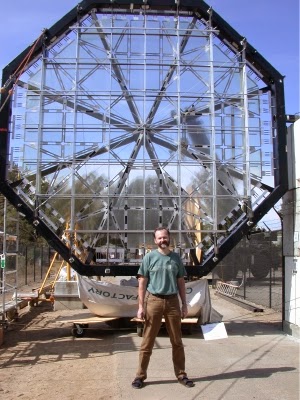This past week, I visited the Griffith Observatory in Los
Angeles, California. I had previously thought it was just a few telescopes and
maybe a presentation room, but I was pleasantly surprised to see how extensive
the exhibits were.
Proof that I visited the Observatory: me with an employee
I spent about two hours perusing through the different rooms
in the Observatory and found quite a few incidents of art and science merging.
I came across a replica of the “Aztec Calendar Stone,” a beautiful circular
piece of art that depicts twenty symbols representative of the 260 day Aztec
calendar year. The Aztecs believed they were living in the era of the fifth sun
due to the fact that four civilizations before them had ended in destruction.
The Aztecs even had a day on the calendar that they believed the fifth sun era would
end on. This incredible piece of artwork was a classic example of technology
integrated with art. The Aztec Calendar Stone served more than just an
aesthetic function; it was also a mode of celebrating and sharing their
advancements in science and math.
The Aztec Calendar Stone
One of the most interesting exhibits I came
across was called “The Cosmic Connection,” a scaled timeline of the universe’s
existence that spans many hallways long. A woman named Kara Knack donated 2,200
pieces of celestial jewelry to create the foreground of this timeline. The
sheer amount of jewelry she has collected in her lifetime contrasted with the
backdrop of the universe truly inspires awe into the viewer as you trace
history from 14 billon years ago to now with no break in the jewelry pattern. It
took me about fifteen minutes to take in the entirety of this exhibit: the history of the universe
as well as the seemingly endless amount of jewelry. “The Cosmic Connection” is
another example of science and art collaborating to create an impressive exhibit.
The beginning of the universe
Just a glimpse into how long the exhibit is
I saw many exceptional exhibits and
learned quite a bit during my time at the Griffith Observatory. The Observatory is known as a science museum rather than art museum, but it was not difficult to find examples of art if you look for it. I would
definitely recommend the Griffith Observatory to any science enthusiasts.
REFERENCES
Aztec Calendar Stone, Griffith Observatory. Personal photograph by author. 2015.
Beginning of Cosmic Connection Exhibit, Griffith Observatory. Personal photograph by author. 2015.
Length of Cosmic Connection Exhibit, Griffith Observatory. Personal photograph by author. 2015.
With Employee, Griffith Observatory. Personal photograph by author. 2015.












